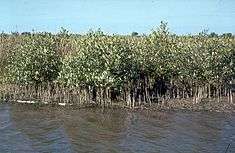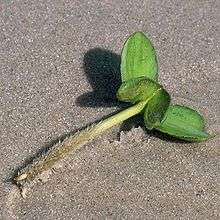Avicennia
Avicennia is a genus of flowering plants currently placed in the bear's breeches family, Acanthaceae. It contains mangrove trees, which occur in the intertidal zones of estuarine areas and are characterized by its "pencil roots", which are aerial roots. It is commonly known as api api, which in the Malay language means "fires", a reference to the fact that fireflies often congregate on these trees.[2] Species of Avicennia occur worldwide south of the Tropic of Cancer.
| Avicennia | |
|---|---|
 | |
| Avicennia germinans | |
| Scientific classification | |
| Kingdom: | Plantae |
| Clade: | Tracheophytes |
| Clade: | Angiosperms |
| Clade: | Eudicots |
| Clade: | Asterids |
| Order: | Lamiales |
| Family: | Acanthaceae |
| Subfamily: | Avicennioideae Miers |
| Genus: | Avicennia L.[1] |
| Species | |
|
See text | |
| Synonyms | |
The taxonomic placement of Avicennia is contentious. In some classifications, it has been placed in the family Verbenaceae, but more recently has been placed by some botanists in the monogeneric family Avicenniaceae. Recent phylogenetic studies have suggested that Avicennia is derived from within Acanthaceae, and the genus is included in that family in the Angiosperm Phylogeny Group system.
Designation of species is made difficult by the great variations in form of Avicennia marina. Between eight and 10 species are usually recognised, with A. marina further divided into a number of subspecies.
The generic name honours Persian physician Avicenna (980-1037).[3]
Description
Members of the genus are among the most salt-tolerant mangroves and are often the first to colonise new deposits of sediment. The sap is salty, and excess salt is secreted through the leaves. The spreading root system provides stability in shifting substrates. Vertical roots called pneumatophores project from the mud, thus the term "pencil roots". These are used in gas exchange as very little oxygen is available in the mud. The flowers are fragrant and rich in nectar, and are pollinated by insects. The embryos exhibit cryptovivipary, a process where they start to develop before the seed is shed, but do not break through the outside of the fruit capsule.[4]
List of species

- Avicennia alba Blume
- Avicennia balanophora Stapf & Moldenke[5]
- Avicennia bicolor Standl.[6]
- Avicennia germinans (L.) L.[7]
- Avicennia integra N.C.Duke[8]
- Avicennia marina (Forssk.) Vierh.[9]
- Avicennia officinalis L.[13]
- Avicennia schaueriana Stapf & Leechm. ex Moldenke[14]
- Avicennia tonduzii Moldenke[15]
References
- "Genus: Avicennia L." Germplasm Resources Information Network. United States Department of Agriculture. 2006-03-30. Retrieved 2010-05-26.
- Api-api Putih (Avicennia alba) The Tide Chaser. Retrieved 2012-02-08.
- Quattrocchi, Umberto (2000). CRC World Dictionary of Plant Names. 1 A-C. CRC Press. p. 242. ISBN 978-0-8493-2675-2.
- Api Api Mangrove and wetland wildlife at Sungei Buloh Nature Park. Retrieved 2012-02-08,
- "Avicennia balanophora Stapf & Moldenke — The Plant List". www.theplantlist.org.
- "Avicennia bicolor Standl. — The Plant List". www.theplantlist.org.
- "Avicennia germinans (L.) L. — The Plant List". www.theplantlist.org.
- "Avicennia integra N.C.Duke — The Plant List". www.theplantlist.org.
- "Avicennia marina (Forssk.) Vierh. — The Plant List". www.theplantlist.org.
- "Avicennia marina subsp. australasica (Walp.) J.Everett — The Plant List". www.theplantlist.org.
- "Avicennia marina subsp. eucalyptifolia (Valeton) J.Everett — The Plant List". www.theplantlist.org.
- "Avicennia marina var. rumphiana (Hallier f.) Bakh. — The Plant List". www.theplantlist.org.
- "Avicennia officinalis L. — The Plant List". www.theplantlist.org.
- "Avicennia schaueriana Stapf & Leechm. ex Moldenke — The Plant List". www.theplantlist.org.
- "Avicennia tonduzii Moldenke — The Plant List". www.theplantlist.org.
Further reading
- Boland, D.J. (1984). Forest Trees of Australia (4th ed.). CSIRO Publishing. ISBN 0-643-05423-5..
- Duke, N.C. (1991). "A Systematic Revision of the Mangrove Genus Avicennia (Avicenniaceae) in Australasia". Australian Systematic Botany. 4 (2): 299–324. doi:10.1071/SB9910299.
- Schwarzbach, Andrea E.; McDade, Lucinda A. (2002). "Phylogenetic Relationships of the Mangrove Family Avicenniaceae Based on Chloroplast and Nuclear Ribosomal DNA Sequences". Systematic Botany. 27: 84–98.
![]()
![]()
External links
- Avicennia in BoDD – Botanical Dermatology Database
- "Avicennia L". Atlas of Living Australia.